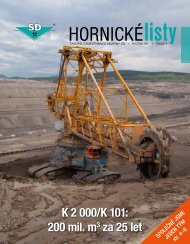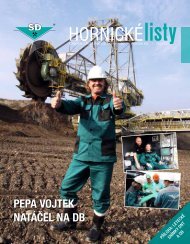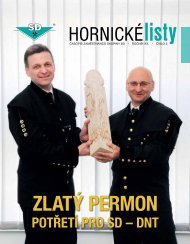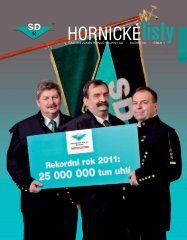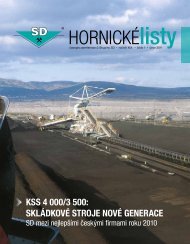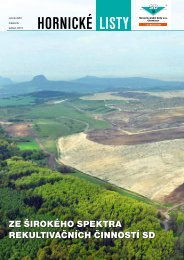annual report 2004 - Severočeské doly a.s.
annual report 2004 - Severočeské doly a.s.
annual report 2004 - Severočeské doly a.s.
Create successful ePaper yourself
Turn your PDF publications into a flip-book with our unique Google optimized e-Paper software.
56<br />
——<br />
57<br />
Notes to Consolidated Financial Statements for the Year Ended<br />
December 31, <strong>2004</strong><br />
1. General<br />
<strong>Severočeské</strong> <strong>doly</strong> a.s. (“<strong>Severočeské</strong> <strong>doly</strong>” or “the Company”) is a Czech Republic joint-stock company, which was<br />
established on January 1, 1994 and its registered seat is in Chomutov, Czech Republic. The Company was established<br />
by merging of two state owned enterprises Doly Nástup Tušimice and Doly Bílina. As of December 31, <strong>2004</strong> the state<br />
represented by National Property Fund held 55.4% of its shares.<br />
<strong>Severočeské</strong> <strong>doly</strong> is a mining company, which has approximately 45% share in lignite market in the Czech Republic.<br />
The Company has an agreement with ČEZ, a.s., the dominant electricity producer in the Czech Republic and<br />
a holder of 37.2% of the Company’s outstanding shares, to supply lignite to ČEZ’s five fossil power plants in the North<br />
Bohemia region and certain large fossil power plants elsewhere in the Czech Republic. As a result, approximately<br />
79% of the lignite production was supplied to ČEZ, a.s., which represented 60% of ČEZ’s coal consumption. The Company<br />
operates two separate mines; the Nástup Tušimice (“DNT”) mine and the Bílina (“DB”) mine. The geological reserves<br />
of the mines amount to 1,019 million tons of lignite from which 549 million tons can still be mined. Annual production<br />
of the mines is about 22 million tons of lignite, with an overburden roof approximately 77 million cubic meters<br />
of earth.<br />
The financial statements were authorised for issue by Erich Grünbaum, Chief Financial Officer of <strong>Severočeské</strong><br />
<strong>doly</strong> a.s., on February 18, 2005.<br />
2. Summary of Significant Accounting Policies<br />
Statement of Compliance<br />
The consolidated financial statements of <strong>Severočeské</strong> <strong>doly</strong> a.s. have been prepared in accordance with International<br />
Financial Reporting Standards (“IFRS”).<br />
Basis of Preparation<br />
The consolidated financial statements are prepared under the historical cost convention, except that available-forsale<br />
investments are stated at their fair value (see Note 5).<br />
Changes in IFRS<br />
The International Accounting Standards Board (IASB) introduced many changes to the International Financial<br />
Reporting Standards and issued new standards and interpretations during 2003 and <strong>2004</strong> that will be valid from<br />
1 January 2005 or later. Therefore, it is possible that the IFRS financial statements for the year ended 31 December<br />
2005 or later will contain comparative data for the year <strong>2004</strong> that will differ from the data presented in these financial<br />
statements. The Company is currently assessing the impact that new or revised standards will have on the Group<br />
accounting policies and financial data presented.<br />
Principles of Consolidation<br />
The consolidated financial statements of <strong>Severočeské</strong> <strong>doly</strong> (“the Group”) include <strong>Severočeské</strong> <strong>doly</strong> a.s. and<br />
the companies that it controls (see Note 17). This control is normally evidenced when the Company owns, either<br />
directly or indirectly, more than 50% of the voting rights of a company’s share capital or is able to govern the financial<br />
and operating policies of an enterprise so as to benefit from its activities. The equity and net income attributable<br />
to minority shareholders’ interests are shown separately in the Consolidated Balance Sheets and the Consolidated<br />
Statements of Income, respectively.<br />
The purchase method of accounting is used for acquired businesses. Companies acquired or disposed of during<br />
the year are included in the consolidated financial statements from the date of acquisition or to the date of disposal.<br />
Intercompany balances and transactions, including intercompany profits and unrealized profits and losses are<br />
eliminated. Unrealized losses are eliminated similarly but only to the extent that there is no evidence of impairment<br />
of the asset transferred.<br />
Investments in associates are accounted for by the equity method of accounting. Associates are entities over<br />
which the Group generally has between 20% and 50% of the voting rights, or over which the Group has significant<br />
influence, but which it does not control. Unrealized gains on transactions between the Group and its associates are<br />
eliminated to the extent of the Group’s interest in the associates; unrealized losses are also eliminated unless<br />
the transaction provides evidence of an impairment of the asset transferred. The Group’s investment in associates<br />
includes goodwill (net of accumulated amortization) on acquisition. When the Group’s share of losses in an associate<br />
equals or exceeds its interest in the associate, the Group does not to recognize further losses, unless the Group<br />
has incurred obligations or made payments on behalf of the associates.<br />
Consolidated financial statements are prepared using uniform accounting policies for like transactions and other<br />
events in similar circumstances.





